Inov-8 Parkclaw G 280
Test Location: San Francisco, CA
Test Duration: 90 miles
Stated Stack Height (Men’s): 29 mm (heel) / 21 mm (forefoot)
Stated Heel-to-Toe Drop: 8 mm
Stated Features:
- 4 mm lugs designed to switch seamlessly between road and trail
- A Graphene-enhanced rubber outsole for superior grip
- A Graphene-enhanced foam midsole for better cushioning and energy return
- 6 mm BOOMERANG insole provides extra cushioning and rebound
- A wide fit and steeper heel-to-toe drop for comfort and efficiency over longer distances
Stated Weight: 280 g (Men, size 9) / 280 g (Women, size 10.5)
Blister’s Measured Weight (US Men’s size 9):
- Shoes + Laces: 254 g (right) & 252 g (left)
- Insoles: 30 g (right) & 30 g (left)
- Total: 284 g (right) & 282 (left)
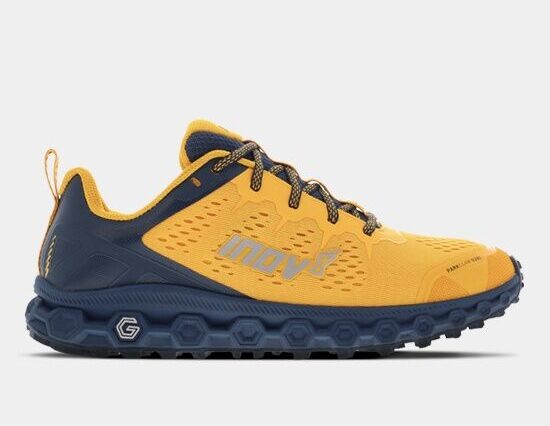
MSRP: $180
Size Tested: US Men’s 9 / EU 42
Reviewer: 5’8”, 150 lbs / 173 cm, 68 kg
Intro
The ability to push off for a trail run from your doorstep is a huge privilege, and one that I’ve heard friends squabble over when entertaining fantasies about buying a home in the Bay Area on Zillow. “TTD” or “Time to Dirt” is a metric as important to many trail runners as mortgage rates and square footage. Living proximal to trail networks puts one less car on the road and smooths out commutes to and from trailheads, allowing you to spend more time, well, actually running. However, unless you’re lucky enough to live somewhere with backyard access to trails, chances are most of your early miles begin with unforgiving cement and involve navigating a bit of road before hitting dirt. Though maybe brief, pounding pavement in true trail shoes — apart from sounding unpleasantly like the thwapping of all-terrain tires on the interstate — can really eat away at their tread, reducing their lifespan.
Fortunately, the proliferation of trail running and its accompanying industry over the past few years has enabled footwear brands to design shoes for niche applications like these. “Road-to-trail” shoes exist to remedy the either/or conundrum facing runners whose routes encompass mixed terrain. Also known as “hybrid” models, shoes in this category are considered generalists, which makes them well suited as a versatile option for folks who travel or those who like to keep their shoe quiver down to a spartan pair or two. Some of the best examples to have surfaced in recent memory come from brands with split attention between their road and trail lineups. Footwear giants like Hoka and Nike are at a far greater advantage when it comes to making sound hybrid shoes than brands that skew in either direction.
With the release of the Parkclaw G 280, Inov-8 seeks to buck this trend. The British footwear brand has long been associated with making minimal trail shoes designed with the distinct rigors of fell running in mind (see our Brand Guide to learn about their entire lineup). Fells are often incredibly steep and interrupted by soft bogs (a topic we discuss in depth with Paddy O’Leary on our Off The Couch Podcast), so many of Inov-8’s original mud shoes make use of narrow / precise fits, stripped down constructions, and cleat-like outsoles to meet those demands. However, the Parkclaw G 280, Inov-8’s entry into the hybrid shoe category, is billed as “the ultimate road-to-trail running shoe,” a title that falls outside of their traditional scope. From my perspective, the Parkclaw G 280 is the brand’s attempt to migrate some of the technology that has worked so well for them on their trail models over to a more versatile type of shoe, and they’re well justified in doing so. Inov-8 argues that the extensive amounts of Graphene they’ve managed to work into the Parkclaw G 280 grants the shoe superior traction on unstable terrain from lugs modest enough to stay out of the way when running on roads.
As someone whose weekday runs frequently meander through park trails and side streets, I was curious to test the legitimacy of these claims. I’ve since put 90 miles on the Parkclaw G 280 over the last few weeks, and in my experience, the shoe mostly delivers on many of the promises Inov-8 makes. In this review, I’ll break down how well the Parkclaw G 280 fared on my local roads and trails, and whether or not I think the shoe falls victim to its own ambitions.
Fit
As always, we recommend trying shoes on in person before you buy them, and that applies equally to the Parkclaw G 280. I’ll provide some personal context for how the shoe fits my feet, but my assessment is by no means comprehensive, so again, try them on in person if possible. For reference, I have fairly wide, high-volume feet with a neutral arch.
Inov-8 uses a range of five different lasts across their lineup, which they label from 1 to 5 on their “Fit Scale.” Precision racing shoes like the Mudclaw G 260 V2 fall on the narrow end of that spectrum, with ultra-distance oriented models like the Trailfly G 270 occupying the opposite extreme. The Parkclaw G 280 lands solidly at a 4 out of 5, making it one of the brand’s higher-volume options. On foot, the shoe felt incredibly spacious all the way from the toe box, through the midfoot, to the heel. It has a rather broad and boxy silhouette, and while I don’t have particularly narrow feet by any means, I was initially concerned that the shoe’s lack of apparent structure would prevent me from dialing in the secure fit I’m accustomed to. However, the Parkclaw G 280 snapped into place once laced up. Padding on the heel counter, heel collar, and tongue conformed tightly to my foot, but did so in a way that felt supportive and generous, far from harsh or bruising. The fit of the shoe hasn’t changed much at the 90-mile mark; my toes still have plenty of space to splay, midfoot lockdown is right where I need it to be, and the flexible heel counter continues to hold my hindfoot in place on climbs. These are all features I look for when trying on a true trail shoe, and the Parkclaw G 280’s fit is more reminiscent of a model built to tackle dirt and rock than any road shoe I’ve tested.
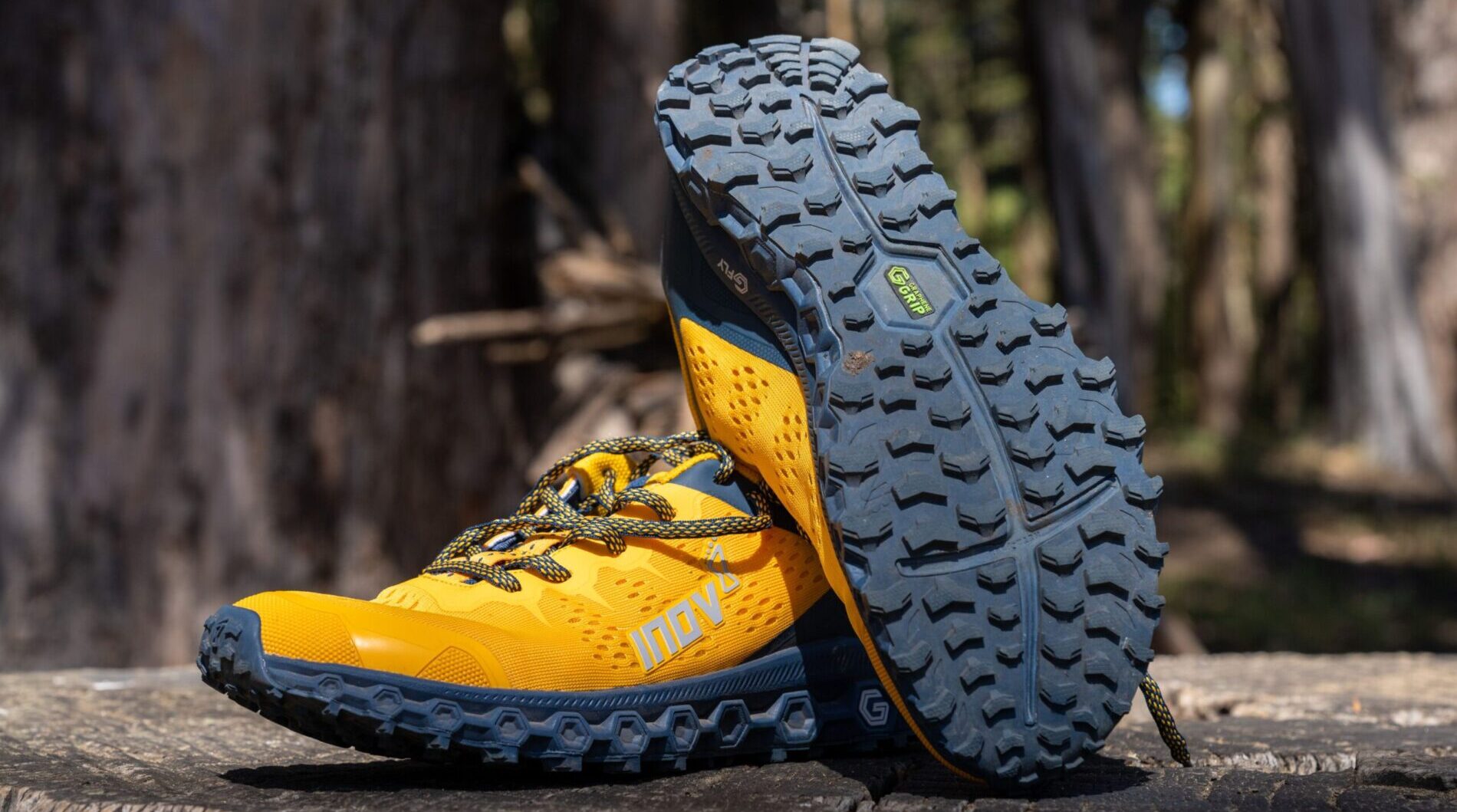
Even though the Parkclaw G 280 features one of Inov-8’s wider lasts, I don’t think that necessarily precludes it as an option for runners with narrow / low volume feet. Out of the box, the shoe’s throat and ankle collar gape and the upper billows out slightly over the outsole near the arch. But when on foot, the Parkclaw G 280 does a tremendous job of drawing itself in to adjust to just about any foot shape. It’s still not as wide / high volume as shoes like the Topo Athletic MTN Racer 2, but it will have a much more accommodating fit than models like the Salomon Pulsar or the Nike Zoom Terra Kiger 8. On that note, I did notice that the Parkclaw G 280’s footbed lacked much of a raised arch on its medial side, which is something to keep in mind for folks coming from stability shoes to correct overpronation. I happen to struggle with excessive supination, so the Parkclaw G 280’s relatively low stack height and lay-flat footbed benefited me.
Weight
The Parkclaw G 280 weighs in at about 280 g / 9.9 oz for a US Men’s Size 9, positioning it at the lighter end of similar hybrid models from other brands. Because a definition of the road-to-trail category is still pretty opaque, with shoes originally designed to be exclusively used off roads gaining second lives as options for both, finding a context for the Parkclaw G 280’s weight was tricky. That said, here’s how the shoe stacks up compared to recent models I’ve seen commonly used on both roads and trails. (All stated weights are based on a US Men’s size 9):
258 g / 9.1 oz — Hoka Torrent 2
272 g / 9.6 oz — Hoka Challenger ATR 6
280 g / 9.9 oz — Inov-8 Parkclaw G 280
280 g / 9.9 oz — On Cloudvista
290 g / 10.2 oz — La Sportiva Karacal
290 g / 10.2 oz — Salomon Sense Ride 4
295 g / 10.4 oz — Nike React Pegasus Trail 4
298 g / 10.4 oz — Brooks Cascadia 16
303 g / 10.7 oz — Topo Athletic MT-4
Most road-to-trail shoes are designed to be pretty utilitarian, and the Parkclaw G 280’s weight reflects that. It’s not the lightest shoe on this list, but it doesn’t need to be to perform its duties. On pedestrian weekday runs around my neighborhood after a big weekend of training, the Parkclaw G 280 is nimble enough.
Upper
I recall wincing slightly when I saw the Parkclaw G 280’s upper for the first time. It looked baggy, fragile, and hastily organized, like someone had rescued it from a bin of spare parts. I suppose I expected something with ornate overlays or a clever lacing system for my $180. I also recall feeling pangs of guilt for slandering the shoe, because after only a few runs, the Parkclaw G 280’s knitted mesh upper completely won me over.
The upper’s dominant theme is padding. Inov-8 pillows the Parkclaw G 280’s tongue, heel collar, and heel counter with a good amount of cushion. In some shoes, this can lead to a sloppy fit, but here I think the extra material helps brace the foot before lacing locks it into place. The Parkclaw G 280’s broad tongue and thick laces provide good coverage over the entire midfoot, acting as a proxy for welded overlays, which are noticeably absent. “Snug fit” is overused in reviews, but I’m struggling to find another way to describe how the Parkclaw G 280’s padded mesh and stout tongue affect the feel of the shoe.
The rest of the shoe’s upper stays pretty frugal. The vamp is made from lightweight engineered mesh with ventilation ports dotted around the toe box and along each side of the midfoot. A textured rubber toe rand leads into a thicker toe cap, forming the extent of the Parkclaw G 280’s forefoot protection. While I’d want a bit more defense on rougher terrain, the upper’s nakedness suits the shoe’s purpose as a road-to-trail option and allows it to breathe much better than many trail models I’ve tested.
Midsole
If you’re not familiar with Graphene, you damn sure will be by the end of this review. Inov-8 stakes their hopes and dreams in this material, and for good reason. Graphene has a lot going for it. It’s simultaneously one of the thinnest compounds known to man and reportedly 200 times stronger than steel. Because it is so thin (like, “a single atom” thin), Graphene is also tremendously flexible, more so than materials like Kevlar or Dyneema. Inov-8 began incorporating Graphene into their shoes a few years ago, beginning with their outsole composition. I’ve run in my fair share of Inov-8 shoes with Graphene-enhanced “G-GRIP” rubber and I’ve always walked away impressed by how long the tread stayed tacky (especially given their level of grip). My eyes are the first to roll when brands make pronouncements about their proprietary technologies, but I had trouble poking holes in any made by Inov-8.

On the heels of their success with G-GRIP rubber, Inov-8 debuted “G-FLY” in 2021, apparently the world’s first Graphene-enhanced foam (I won’t attempt to explain what form that “enhancement” takes, but Inov-8 claims it improves energy return and durability). The Parkclaw G 280 is the first model I’ve tested to feature this new midsole compound. This time around I left my incredulity at the door. Underfoot, G-FLY felt consistently firm upon impact before dampening slightly as I rolled through my footstrike. I never felt a ton of energy return or emphatic pop from the shoe, but it didn’t feel completely dead or lame either, and that kind of neutral in-betweenness remained consistent over my testing period. The Graphene-enhanced foam kept its shape much better than both Hoka’s “PROFLY” and Nike’s “React” compositions. In fact, it felt much closer to the dual-density compressed EVA La Sportiva uses in models like the Karacal, though maybe a touch softer. On harder surfaces, the Parkclaw G 280 ticked over just fine, and the shoe’s lack of a rock plate and its flexible midsole granted me above average ground feel on trails.
In our review of the Trailfly G 270 (formerly Terraultra G 270), Gordon noted the complementary cushion Inov-8’s “BOOMERANG” footbed added, lauding Inov-8 for recasting neglected parts of shoes. The same BOOMERANG insoles are used in the Parkclaw G 280. They’re made from a similar TPU-bead-based material Adidas uses for their “Boost” foam, and Inov-8 actually includes their thickness in the Parkclaw G 280’s 29 mm / 21 mm stack height. While swapping the BOOMERANG insoles out in favor of aftermarket ones will likely subtract from the midsole’s suppleness, I don’t think doing so will completely redefine how the shoe feels on foot.
Outsole
Inov-8 isn’t quick to forget their fell-running heritage. Though the brand operates internationally and has expanded their lineup to include models outside of those specific to UK mountain running, influences from their original mud shoes crop up in just about every product they make. Outsole design has always been something Inov-8 has prioritized. It’s an aspect of their shoes that reflects their history, their home. Over time, they’ve garnered a reputation for creating some of the industry’s best lug patterns for technical conditions, on par with the likes of Vibram MegaGrip and La Sportiva’s “FriXion” compounds. But how much would Inov-8’s tradition help them with the Parkclaw G 280, a shoe intended for roads and light trails?
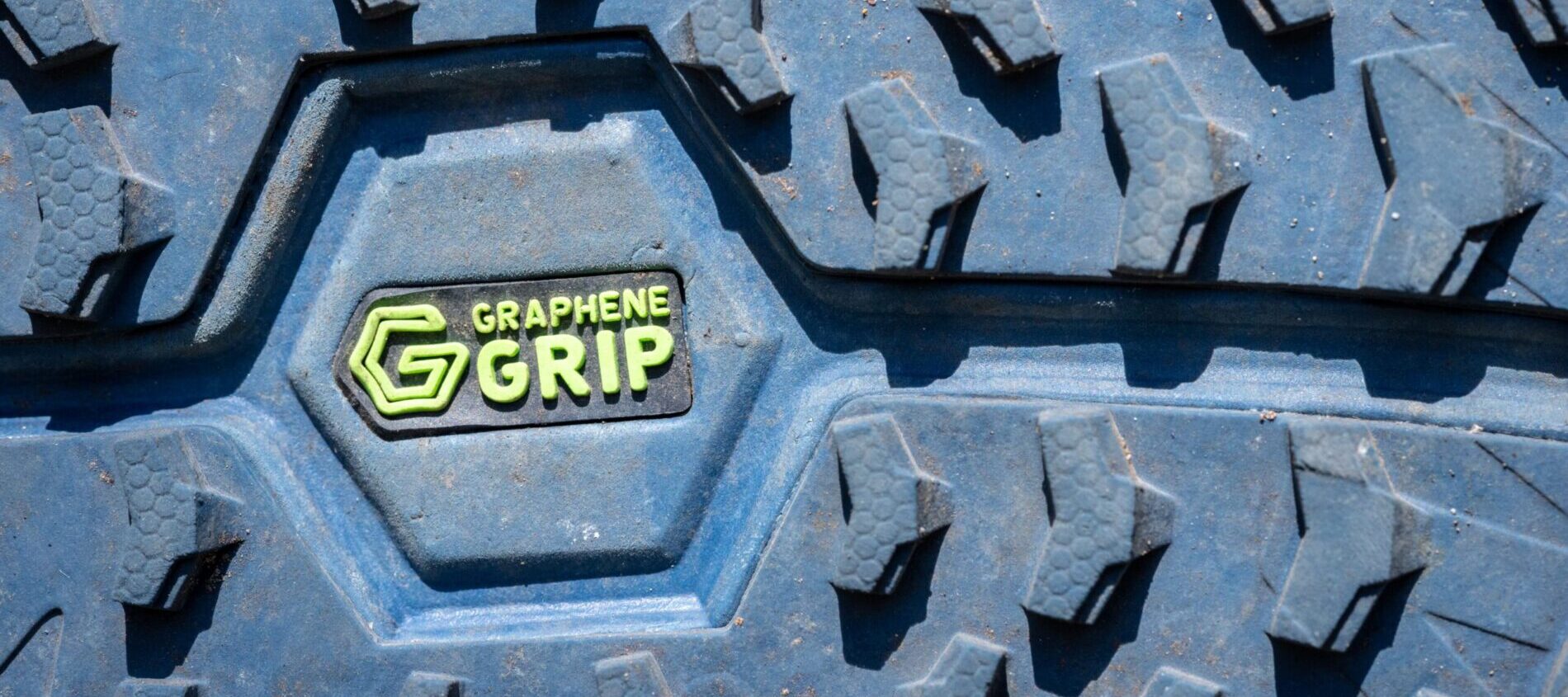
Turns out, quite a bit. The success of the Parkclaw G 280’s outsole starts with Graphene (I warned you we’d spend a lot of time on this). The shoe’s G-GRIP rubber is top notch, both in terms of stickiness and toughness. It’s tacky and hard like Salomon’s “Contagrip,” but the flex groove that runs the length of the outsole and the absence of a rock plate permit the rubber to flex when needed. 98 chevron-shaped 4 mm lugs (I counted every single one) crowd the bottom of the shoe and help provide firm purchase on softer materials like dirt or grass. Their compact grouping also increases ground contact / surface area on pavement to facilitate a cleaner foot strike. The shoe did an impressive job of maintaining traction on wet surfaces too, be they slippery manhole covers or greasy roots.
Running in any kind of trail shoe on roads is normally a surefire way to divebomb its life expectancy, yet the Parkclaw G 280’s outsole still has no signs of wear after about 90 miles. Inov-8 claims that their Graphene-enhanced rubber is 50% more durable than other rubber compounds, and I have no reason to doubt that contention (especially given our other reviewers’ long-term experiences wit hit). However, I can’t help but think that one of the main reasons my pair has remained in such good condition is because I’ve been unconsciously trying to avoid running on pavement as much as I can. The Parkclaw G 280 leans more trail than road, and nowhere is that more apparent than in the shoe’s outsole. While I can stomach scuffing the tread on cement for a mile or two, that’s enough to dissuade me from wearing the Parkclaw G 280 on any dedicated road runs. It’s truly a “road-to-trail” model, in every sense of the phrase.
On Trail
I live in a pretty densely populated city that puts me out of practical range from run-commuting to most trailheads. To escape urban sprawl requires hopping on a normally congested freeway and includes a $7 toll, a hefty price to pay for a short shakeout, or even a medium-distance jaunt. For days when I just need to get my mileage in, or when I’m short on time, I’ll opt for a local route from home. San Francisco is held together by cells of urban trails that can be easily linked together to form a tidy network with only minimal amounts of pavement. There’s generally still enough of it to confuse the choice between wearing road or trail shoes though, but Inov-8’s Parkclaw G 280, a veritable trail shoe with road leanings, has helped clear up that dilemma.
As I mentioned earlier in this review, the Parkclaw G 280 feels much more at home on soft dirt trails than it does on roads. Some might slam the shoe’s bias, arguing its limitations on paved surfaces as evidence of its failure as a road-to-trail option. But I think that shows a misreading of what a true road-to-trail shoe is designed to do, namely to bridge the cement gap separating your doorstep from the dirt. In my opinion, there shouldn’t be an expectation that a road-to-trail shoe must perform equally well on both roads and trails. With that understanding, the Parkclaw G 280 is a triumph.
The Parkclaw G 280 has been my preferred shoe for urban trail runs ranging from 7 to 12 miles. Inov-8’s G-FLY midsole and BOOMERANG footbed provide just enough cushioning for efforts of about that distance. The pairing between the two materials contributes to a firm ride, with dampening on impact and takeoff, though this effect is felt considerably less so on stretches of road more than a few miles long. The shoe’s 8 mm drop is conducive to running on harder surfaces, but the Graphene outsole frequently felt like it didn’t want to let go of the ground, and the G-FLY midsole isn’t soft enough for my preferences. As such, I’ve been conscious about breaking up sections of pavement with dirt while wearing the shoe, and I can sense the Parkclaw G 280’s relief when I hop onto softer surfaces.
Once off-road, these shoes jam. Their G-GRIP rubber eats up slick trails, and the shoe’s flexible outsole / midsole pairing allows for great ground feel on off-camber terrain. The Parkclaw G 280’s Graphene-enhanced outsole / midsole is also pretty hard, so I’d still consider the shoe fairly protective against small rocks and debris, even in the absence of a rock plate. This allowed me to be a little less precise with my foot placement at faster paces, and the shoe’s cushioned and accommodating upper helped me reach a precise fit for when I did need to be a bit more accurate. My midfoot and heel stayed locked down when climbing, my toes had plenty of real estate to splay, and I didn’t encounter any toe-smashing on descents. On trail, the Parkclaw G 280 reminded me of a slightly firmer version of the Hoka Torrent 2 and a wider fitting, more off-road-capable version of the On Cloudvista. In my experience, the Parkclaw G 280’s energy return isn’t as pronounced as either of these models, but that’s not of huge importance to me on my leisurely jaunts around Golden Gate Park.
Durability
One of Inov-8’s major claims with the Parkclaw G 280 is principled on the durability of its Graphene-enhanced components. My running style tends to be pretty violent toward midsole foams, and by excessively supinating, I burn through the lateral aspect of outsoles quickly. The Parkclaw G 280 looked a little flimsy out of the box, so I was a tad skeptical about whether or not I could push it past 200 miles, let alone the 400 to 500 it’s allegedly built for. But the shoe seems unfazed after 90 miles of use — the upper hasn’t frayed or deformed, the midsole hasn’t lost its subtle snap on each end of my foot strike, and all 98 lugs on the G-GRIP outsole are still in good shape.
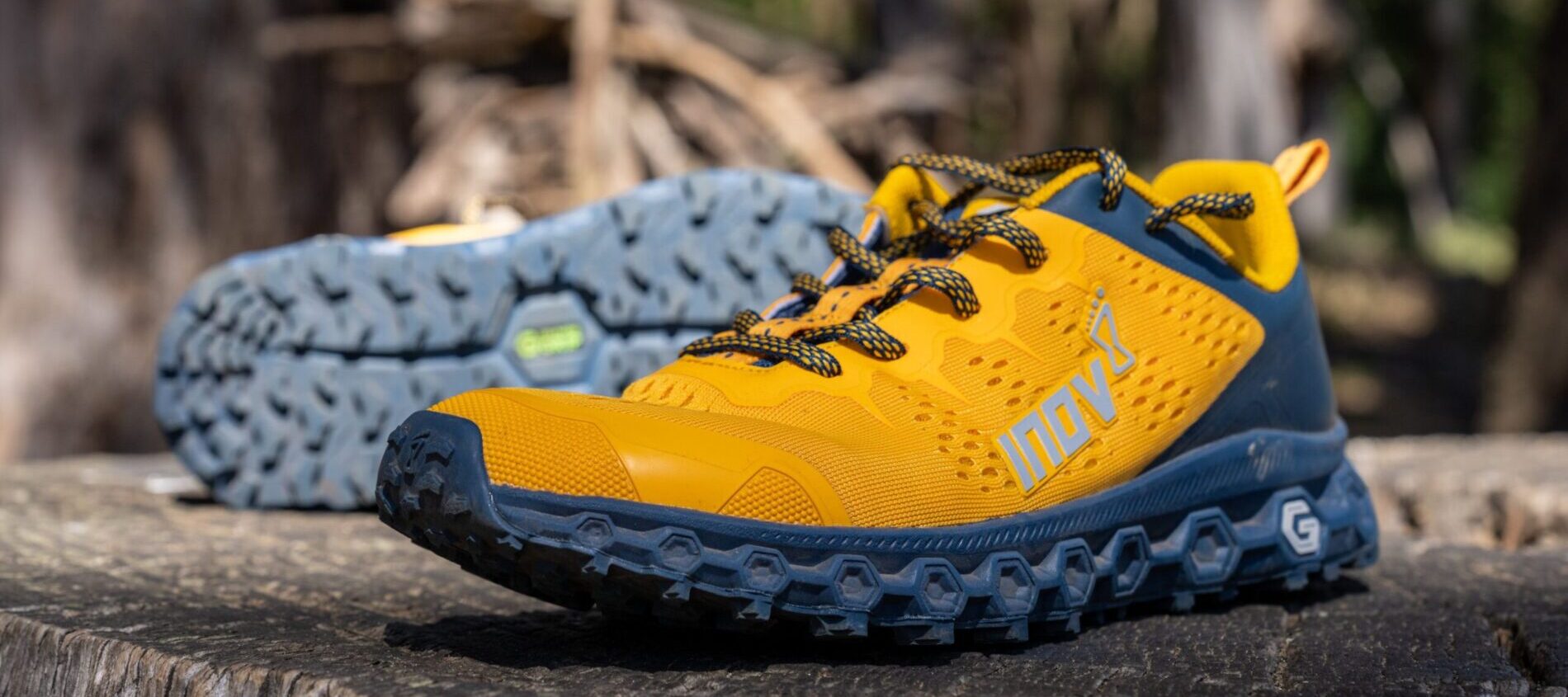
I do question how long the Parkclaw G 280’s BOOMERANG insoles will continue to be energetic, but I imagine replacing them can’t be too hard. The strength of the exposed upper also seems like a big question mark, particularly if the shoe spends the majority of its life on trails. As always, I’ll chime back in with updates if anything changes over the coming months.
Who’s It For?
Road-to-trail shoes are popular for a reason. They reflect the reality of how trail runners living in urban areas (i.e., a lot of us) actually run. Commuting to trailheads during the workweek isn’t practical for a lot of people, but chances are many of us live a runnable distance away from a local park, unpaved bike path, or local trail system. That’s where a shoe like Inov-8’s Parkclaw G 280 proves its worth. $180 is a lot to fork over for a shoe that won’t help you much on race day and doesn’t do anything exceptionally well, but the Parkclaw G 280 is built to withstand a heavy workload and its ability to perform several different roles within a shoe quiver more than justifies its price. In light of its versatility and inclusive fit, I’d make the case that the Parkclaw G 280 would benefit the majority of trail runners who begin and end their excursions from home.
Bottom Line
There’s a timeworn approach to our sport that says the only way to get better at running is to run more. While I know there’s probably room for nuance there, on a base level I think that statement is largely correct, so I follow its principles. Simply put, I’m so high on Inov-8’s Parkclaw G 280 expressly because the shoe allows me to run more. It is one of the only models I’ve tested that I can throw into just about any situation with little consequence, whether that’s ripping singletrack or exploring a new city by foot. While there are better, more durable options for technical terrain, and the Parkclaw G 280 can feel a bit unwieldy if it spends too much time on pavement, I’m hard-pressed to recommend a more preferable shoe for weekday runs that involve a bit of both road and trail.



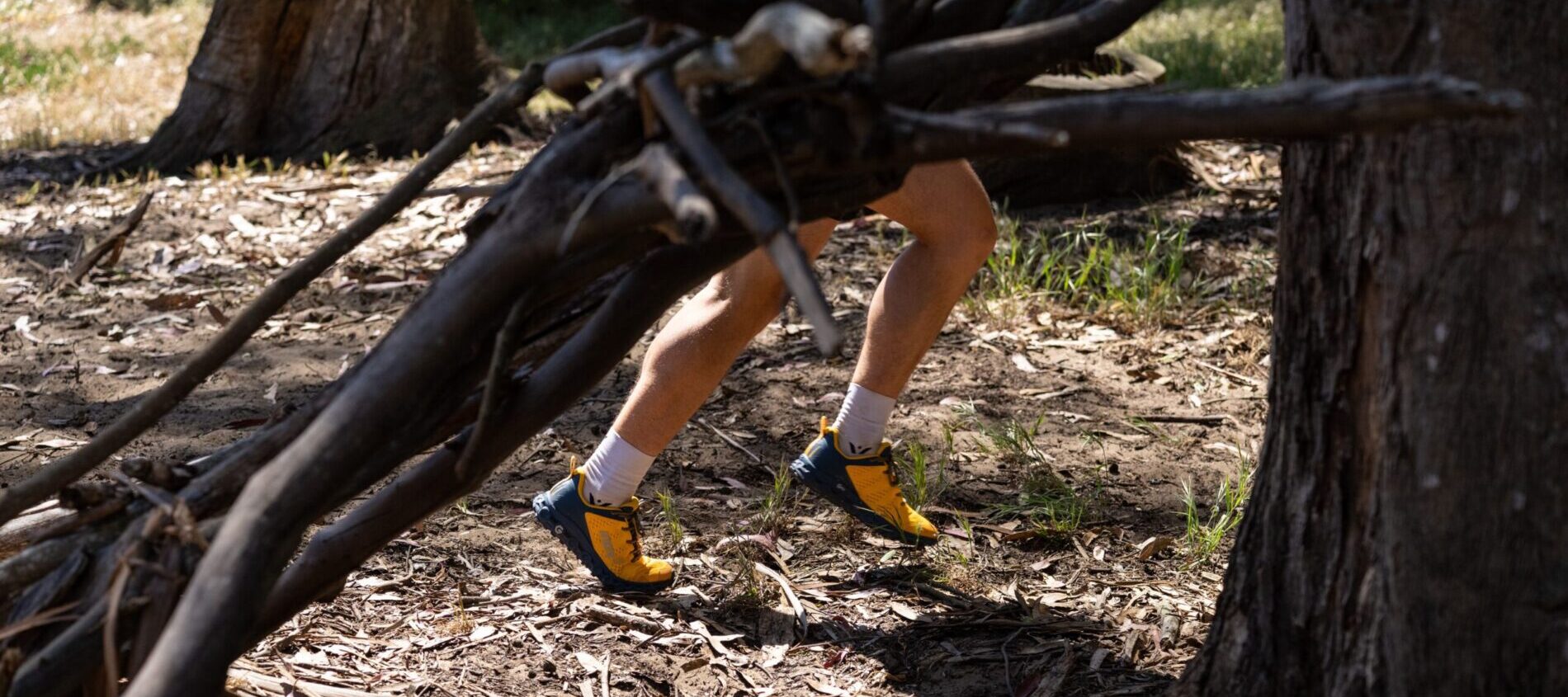

Mine lasted 315 Km before the toe cap and the overlays started to fall apart . Average grip, comfortable fit, good overal feeling. But its too expensive for a shoe that lasted 2 months :(